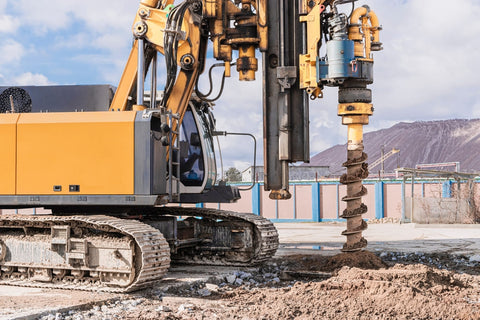Whether you’re running a bulldozer or overhead lights, having an adequate power supply is essential to maintain productivity on your construction site. Equipment used for construction applications has high power demands that single-phase utility power simply can’t meet.
When you need reliable power for your construction machines and equipment, three-phase power supplied by a single-phase to three-phase converter is the way to go.
|
Table of Contents |
Common Types of Heavy Machinery Used in Construction
Excavators
The two main parts of an excavator are the long arm, which is equipped with a digging bucket, and a cab where the operator sits to manage the controls. The cab features 360-degree rotation, making it fully mobile. This machine can either move on treaded wheels or along a track. In addition to digging up ground, an excavator can:
- Lift heavy objects
- Demolish structures
- Dredge rivers
- Cut trees
Backhoe
A backhoe contains a hoe located at the back of the machine and a loading bucket at the front. This piece of heavy equipment is used to excavate trenches at levels lower than that of the machine itself. The hoe digs the ground, and the bucket loads, lifts, and unloads the materials.
Bulldozer
Bulldozers are used to remove the ground’s weakened topsoil layer to a specified depth as well as to lift soil. The sharp metal plate at the front of the machine removes the soil, and hydraulic pistons enable the operator to raise and lower the plate.
Grader
Graders, also known as motor graders, level the ground’s surface to prepare it for road construction. A horizontal blade between the front and back wheels drops to the ground to perform the leveling. Graders are also used to remove unwanted dirt and snow from roads.
Boom Lifts
A boom lift is a type of aerial lift mechanism. It’s also called a basket crane or a cherry picker. The boom extends and contracts, enabling the operator to reach higher heights.
Drills
Automated and non-automated drills are used to drill various holes. Automated drills have features like depth tracking and built-in cameras, which enable operators to complete projects more safely and efficiently. Non-automated drills are just as powerful and can enhance productivity as well as the safety and comfort of workers.

Forklifts
Forklifts are designed to move materials across short distances on a construction site. These are the four main types of forklifts:
- Counterweight: These forklifts feature a counterweight system that keeps the machine stable while it lifts and moves heavy materials.
- Side Loader: Since the operator can load materials from storage, these forklifts are ideal for moving bulky materials in small spaces.
- Pallet Jack: These forklifts are intended specifically to transport wooden and plastic pallets around a construction site or warehouse. Their relatively small size makes them ideal for indoor spaces.
- Warehouse: These forklifts are used exclusively to move materials around a warehouse.
Telehandlers
A telehandler is a type of hoisting equipment used to lift heavy materials to a projected height and give workers a tall platform to work on. It features a telescopic boom that the operator can raise, lower, and move forward. Attachments like buckets, cabs, and jibs can be added to the end of the boom for greater versatility.

Temporary Power for Construction Sites
Machines like backhoes and forklifts aren’t the only types of construction equipment that require three-phase power. Smaller equipment like lights and power tools need a consistent flow of electricity, too.
That’s because construction sites are often located in areas where permanent power infrastructure isn’t available. Power is especially difficult to supply to roadway construction sites. With generators as the only available option, three-phase power is necessary to ensure reliable operation.

Why Power Supply Matters for Construction Equipment
Reliability
When it comes to construction projects, you need a power supply you can count on to get the job done without interruptions. While single-phase power experiences occasional dips in voltage, three-phase power is consistent.
Safety
The more reliable your power supply is, the safer construction workers will be on the job.
Efficiency
A three-phase power supply can transmit three times as much power as a single-phase power supply, making it significantly more efficient.
Cost
The higher efficiency of three-phase power produces lower operating costs for construction crews.
Using Three-Phase Power for Construction Equipment
While single-phase power distributes electricity using two circuits, three-phase power distributes it using three circuits, which delivers electricity more consistently.
Single-phase power is more common in residential spaces, while three-phase power is more common for commercial and industrial applications—like construction projects—that have higher power demands.
Benefits of Using a Phase Converter to Power Construction Equipment
Take a look at the top benefits of powering construction equipment with a phase converter, as opposed to utility power:
- Greater reliability
- Enhanced efficiency
- Reduced downtime
- Increased cost savings
- More consistent results
Power Your Construction Site With Phoenix Phase Converters
When you need power solutions that will increase efficiency and lower costs, Phoenix Phase Converters is the name you can trust. Our digital and rotary phase converters are fully customizable and available in a range of sizes and prices. Browse our collection today to find the phase converter you need for all your construction applications.
